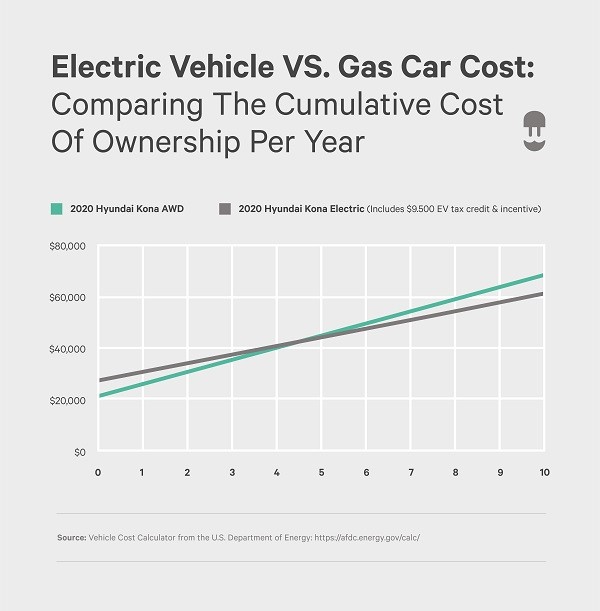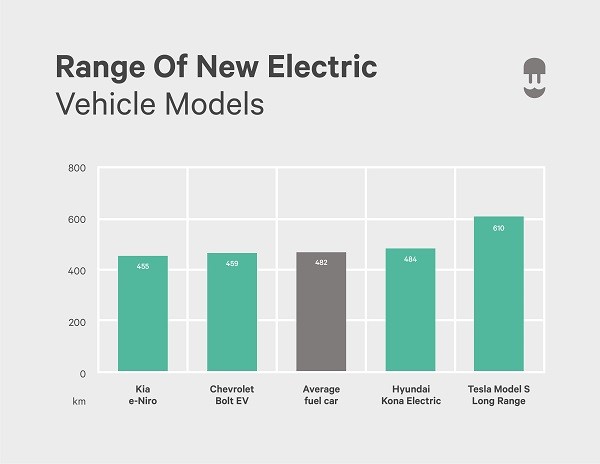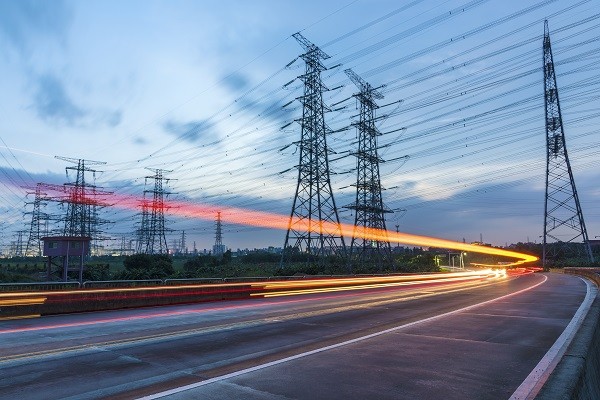Gasoline and electric vehicles compared show that electric vehicles are becoming increasingly competitive. COMPARE.EDU.VN breaks down the key differences to help you make an informed decision. This comparison will cover affordability, performance, range, charging infrastructure, environmental impact, and grid readiness of electric vehicles versus traditional gasoline cars, providing a clear perspective on this evolving automotive landscape.
1. Are Electric Vehicles (EVs) As Affordable As Gasoline Cars?
Yes, electric vehicles (EVs) are becoming increasingly affordable, often proving more economical in the long run. While the initial purchase price of an EV might be higher, factors such as government incentives, lower running costs, and reduced maintenance contribute to their overall affordability.
Many consumers hesitate due to the perceived high cost of electric and hybrid vehicles. However, the reality is shifting. For example, the Nissan Leaf, a popular EV model, starts at a competitive price point. In addition, various government incentives can significantly reduce the initial purchase price, making EVs more accessible.
1.1 Long-Term Savings with EVs
Research indicates that EV owners can save a significant amount annually on operational costs compared to gasoline car drivers. These savings primarily stem from lower fuel costs and reduced maintenance requirements. Electricity is generally cheaper than gasoline, and EVs are more energy-efficient.
1.2 Reduced Maintenance Costs
EVs have fewer moving parts and require less maintenance than gasoline cars. There is no need for oil changes or transmission fluid replacements. Additionally, regenerative braking, a feature in electric cars, extends the lifespan of brake pads by harnessing kinetic energy to recharge the battery.
1.3 Potential Cost Considerations
While EVs offer numerous cost-saving benefits, there are a few factors to consider. The heavier body and instant torque of EVs may lead to more frequent tire rotations and replacements. Furthermore, the eventual replacement of the car’s battery can be a significant expense. However, EV battery technology is constantly improving, with battery life expectancy increasing and costs decreasing.
1.4 Comprehensive Comparison Table
| Feature | Gasoline Car | Electric Vehicle (EV) |
|---|---|---|
| Purchase Price | Potentially Lower | Potentially Higher (before incentives) |
| Fuel Costs | Higher | Lower |
| Maintenance Costs | Higher | Lower |
| Incentives | Few to None | Government and Utility Incentives |
| Long-Term Cost | Higher | Lower |



2. Electric Vehicle (EV) Speed Compared To Gasoline Cars?
Electric vehicles (EVs) often outperform gasoline cars in acceleration due to their instant torque delivery. While gasoline cars rely on combustion engines to generate power, EVs can deliver maximum torque from a standstill, resulting in quicker off-the-line acceleration.
Many people equate power with the sound of a revving engine, mistakenly believing that EVs lack speed and performance due to their quiet operation. However, EVs offer impressive acceleration capabilities.
2.1 Instant Torque Advantage
Electric motors are simpler than internal combustion engines, allowing EVs to provide full torque from 0 kilometers per hour. This results in immediate acceleration, surpassing that of gasoline cars, which take longer to deliver power to the wheels.
2.2 Single-Speed Gear Limitations
The simplified motor design of EVs also has a drawback. Most EVs operate on a single-speed gear, requiring manufacturers to balance acceleration and top speed. This can result in lower top speeds compared to multi-gear gasoline cars.
2.3 Practical Speed Considerations
Despite potentially lower top speeds, the maximum speeds of most popular EVs exceed speed limits in many regions. This makes them more than adequate for everyday driving needs.
2.4 Performance Metrics Comparison
| Metric | Gasoline Car | Electric Vehicle (EV) |
|---|---|---|
| Acceleration | Slower initial acceleration | Faster initial acceleration |
| Top Speed | Potentially Higher | Potentially Lower |
| Torque Delivery | Delayed | Instantaneous |
| Gearbox Complexity | Multi-Gear | Single-Gear |
3. How Does EV Range Compare To Gasoline Cars?
EV range is comparable to gasoline cars for many newer models. Range anxiety is a common concern for potential EV buyers, but advancements in battery technology have significantly increased the driving range of electric vehicles.
Many worry about the distance EVs can travel on a single charge. However, modern EVs are addressing this concern with improved battery performance.
3.1 Range Comparison
While the average gasoline car can travel up to 482 km on a full tank, many electric models offer a range of 200-490 km on a single charge. Models like the Hyundai Kona Electric, Chevrolet Bolt EV, and Kia e-Niro offer ranges similar to gasoline cars.
3.2 Daily Driving Needs
A study shows that the average daily driving distance is between 40 and 90 km, making even older EV models capable of handling daily commutes and errands.
3.3 Extended Range Options
Luxury EVs, such as the Tesla Model S Long Range, can travel up to 610 km on a full charge, making long-distance travel feasible.
3.4 Range Metrics Comparison
| Metric | Gasoline Car | Electric Vehicle (EV) |
|---|---|---|
| Average Range | Up to 482 km | 200-610 km |
| Daily Use | 482 km | 200-610 km |
| Long Distance | Excellent | Good to Excellent |
4. Are There Enough EV Charging Stations?
The growing network of EV charging stations is becoming increasingly supportive of electric vehicle adoption. While the availability of charging stations was once a significant concern, rapid expansion and advancements in charging technology are making EV ownership more convenient.
Many people question the adequacy of the current charging infrastructure. However, this concern is becoming less relevant as the charging network expands.
4.1 Home Charging Convenience
Most EV owners can charge their vehicles at home overnight, eliminating the need to visit public charging stations regularly. This convenience is a significant advantage over gasoline car ownership.
4.2 Expanding Public Charging Infrastructure
The number of public charging stations is increasing rapidly worldwide. EV charging maps, such as Open Charge Map, PlugShare, and Chargemap, provide comprehensive information on charging station locations.
4.3 Growth in Charging Stations
The number of public charging stations in Europe has increased dramatically, from a few thousand in 2011 to hundreds of thousands in 2020. This growth is driven by government and business incentives aimed at expanding the charging infrastructure.
4.4 Charging Infrastructure Comparison
| Feature | Gasoline Stations | Electric Vehicle (EV) Charging Stations |
|---|---|---|
| Home Charging | Not Available | Available |
| Public Availability | Widespread | Growing Rapidly |
| Network Growth | Relatively Static | Rapid Expansion |
| Convenience for Daily Use | Less Convenient for Home | More Convenient for Home |
5. Is EV Charging Fast Enough?
Advancements in charging technology are significantly reducing EV charging times. One of the initial barriers to EV adoption was the perceived long charging times. However, technological advancements have made EV charging faster and more convenient.
Concerns about the time it takes to recharge an EV are common among potential buyers. However, these concerns are becoming less valid with the development of faster charging solutions.
5.1 Overnight Home Charging
EV owners can conveniently charge their cars at home overnight, ensuring a full charge each morning. This eliminates the need for frequent stops at charging stations during the day.
5.2 Fast Charging Technology
Charging times have improved significantly in recent years. Fast chargers can now charge an EV in a fraction of the time compared to older charging technologies.
5.3 Ultra-Fast Chargers
Ultra-fast EV chargers with capacities of 150kW or higher are emerging, promising to charge EVs in minutes rather than hours.
5.4 Charging Speed Comparison
| Factor | Gasoline Refueling | Electric Vehicle (EV) Charging |
|---|---|---|
| Convenience | Readily Available Gas Station | Convenient Overnight Home Charging |
| Speed | Quick (minutes) | Varies (30 minutes to overnight) |
| Technological Advancement | Stable | Rapidly Improving |
6. Are EVs Really Cleaner & Greener Choices?
Yes, electric vehicles (EVs) are indeed cleaner and greener choices compared to gasoline cars. In terms of air pollution, EVs have been shown to outperform their gasoline-powered counterparts.
Skepticism exists regarding the environmental benefits of electric vehicles. However, EVs contribute to a more sustainable future.
6.1 Reduced Emissions
EVs produce zero tailpipe emissions, reducing air pollution in urban areas. The environmental benefit is magnified when the electricity powering EVs comes from renewable sources.
6.2 Smart Charging and Renewable Energy
Smart charging technology enables EVs to align electricity consumption with renewable energy availability, further reducing their environmental impact.
6.3 Production Process Considerations
While the EV production process does generate waste and emissions, research shows that EVs produce fewer emissions over their lifetime than gasoline cars. Improvements are continually being made to reduce the environmental impact of battery manufacturing.
6.4 Environmental Impact Comparison
| Aspect | Gasoline Car | Electric Vehicle (EV) |
|---|---|---|
| Air Pollution | High Tailpipe Emissions | Zero Tailpipe Emissions |
| Energy Source | Fossil Fuels | Electricity (Potential for Renewable Sources) |
| Production Emissions | Lower | Higher (but improving) |
| Lifetime Environmental Impact | Higher | Lower |
7. Is Our Grid Ready For A Full Transition To EVs?
Our grid is increasingly ready for a full transition to EVs, and EVs themselves can contribute to grid stability. Concerns about the grid’s capacity to handle a full transition to electric vehicles are common. However, advancements in technology and grid management are making this transition feasible.
Some people question whether our grids can handle the increased energy demand from a full transition to EVs. However, EVs can be a solution for grids, especially as we move towards more sustainable societies.
7.1 Smart Charging and Grid Management
Smart charging technology allows grid operators to manage energy demand by shifting EV charging to off-peak hours. This reduces the strain on the grid and avoids the need for expensive infrastructure upgrades.
7.2 Bidirectional Charging Capabilities
Bidirectional chargers enable EVs to provide storage capacity to support renewable-heavy grids. EVs can charge at night when demand is low and discharge energy back to the grid during peak hours, enhancing grid stability.
7.3 Grid Readiness Comparison
| Feature | Current Grid | Future Grid with EV Integration |
|---|---|---|
| Energy Demand | Relatively Stable | Increasing (but manageable) |
| Peak Load Management | Limited | Enhanced with Smart Charging |
| Renewable Energy Support | Limited | Supported by Bidirectional Charging |
| Infrastructure Investment | Needed for Significant Demand Increases | Reduced with Smart Charging and Bidirectional Capabilities |
Electric Vehicles Are Future-Proof
Despite temporary setbacks, electric vehicles have a bright future. Interest in EVs remains strong, and consumers are increasingly willing to make the switch to electric. This shift towards electric mobility is essential for a sustainable future.
Call to Action:
Ready to make the switch to electric? Visit COMPARE.EDU.VN today to explore detailed comparisons of electric and gasoline vehicles and make an informed decision that benefits both you and the planet.
Address: 333 Comparison Plaza, Choice City, CA 90210, United States
WhatsApp: +1 (626) 555-9090
Website: compare.edu.vn
FAQ About Electric Vehicles
Q1: How long does it take to charge an electric car?
Charging times vary depending on the charging station’s power and the car’s battery capacity. Overnight home charging is common, while fast chargers can provide a significant charge in about 30 minutes to an hour.
Q2: What is the lifespan of an electric car battery?
Most EV batteries are expected to last around 10 years or more, with many manufacturers offering warranties for at least 8 years.
Q3: Are electric cars more expensive to insure?
Insurance costs for electric cars can vary. While some insurers may charge higher premiums due to the higher repair costs associated with EVs, others offer discounts for their environmental benefits.
Q4: Can electric cars be driven in all weather conditions?
Yes, electric cars can be driven in all weather conditions. They perform well in both hot and cold climates, though extreme temperatures can affect battery range.
Q5: What are the government incentives for buying an electric car?
Government incentives vary by region but often include tax credits, rebates, and subsidies to reduce the purchase price of electric vehicles.
Q6: How do electric cars handle in snow and ice?
Electric cars often have excellent traction control systems and low centers of gravity, which can improve handling in snow and ice.
Q7: What is regenerative braking, and how does it work?
Regenerative braking captures kinetic energy during deceleration and uses it to recharge the battery, increasing efficiency and reducing wear on brake pads.
Q8: Do electric cars require special maintenance?
Electric cars require less maintenance than gasoline cars, as they have fewer moving parts and do not need oil changes or tune-ups.
Q9: How does the range of an electric car affect its usability?
The range of an electric car determines how far it can travel on a single charge. Modern EVs offer ranges that meet the needs of most drivers, especially for daily commutes and errands.
Q10: Are there any environmental concerns associated with electric car batteries?
Environmental concerns include the mining of raw materials and the disposal of batteries. However, recycling processes are improving, and manufacturers are working to reduce the environmental impact of battery production.